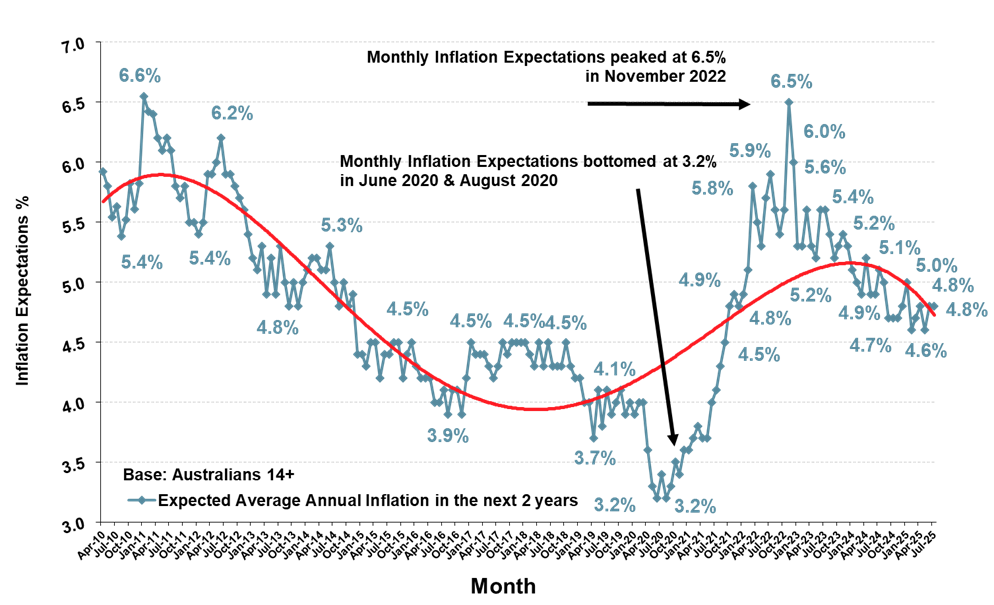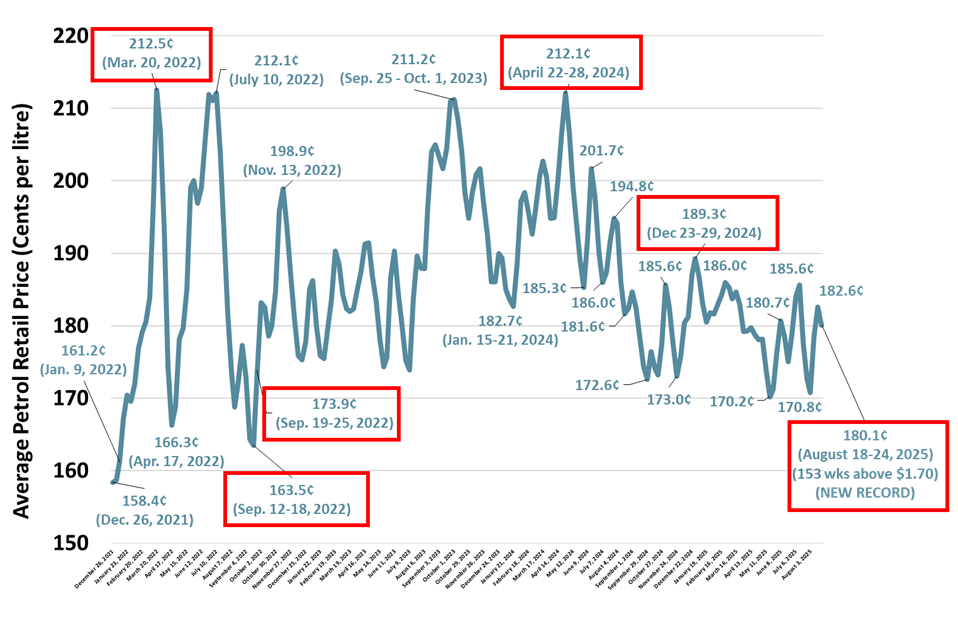ANZ-Roy Morgan Inflation Expectations up slightly to 5% in late August – up from 4.8% for the month of July

The weekly ANZ-Roy Morgan Inflation Expectations were 5% for the week of August 18-24, 2025, up 0.2% points from the month of July, but down from the peak of 5.2% in early August.
A look at monthly Inflation Expectations for July 2025 shows the measure at 4.8% for the month – unchanged from June and level with the average so far this year – also of 4.8%.
Looking back over the last year, weekly Inflation Expectations have moved in a band of 4.2% - 5.2% since the start of July 2024 and averaged 4.8%. In addition, the latest information on weekly Inflation Expectations is available to view each week in the Roy Morgan Weekly Update video on YouTube.
Monthly Inflation Expectations Index long-term trend – Expected Annual Inflation in next 2 years

Source: Roy Morgan Single Source: Interviewing an average of 5,000 Australians aged 14+ per month (April 2010 – July 2025).
Average retail petrol prices increased to $1.80 per litre in July; its highest monthly level since March
During July, average retail petrol prices increased by two cents per litre to $1.80 per litre – this is the highest average retail petrol prices have been for four months since March 2025 ($1.83 per litre).
Average retail petrol prices started the month of July at $1.84 per litre and soon increased to a monthly high of $1.86 per litre in early July, before dropping rapidly to $1.73 per litre by the final week of July. After July ended, average retail petrol prices dropped in early August, but soon increased to as high as $1.83 per litre in mid-August.
Average retail petrol prices hit near three-year lows in May but then rebounded – and this volatility is reflected in the weekly Inflation Expectations of Australians which have moved in a band of 0.7% between 4.5-5.2% during May, June, July and so far in August. On a weekly level, Inflation Expectations have increased seven times, decreased eight times, and been unchanged for two weeks during this period.
Looking longer-term, average retail petrol prices have now been at, or above, $1.70 per litre for a record 153 straight weeks since mid-September 2022 – for almost three years.
Looking back average retail petrol prices have now averaged $1.85 per litre since early March 2024, but this has dropped to an average of $1.77 per litre since mid-April 2025 over the last 18 weeks. The reduction in petrol prices this year has clearly lessened inflation pressures and was no doubt a key factor for the Reserve Bank behind its decision to cut interest rates in February, May and again in early August.
Australian average retail petrol prices (cents per litre) weekly: 2021 – 2025

Source: Australian Institute of Petroleum (AIP) weekly reports: https://www.aip.com.au/pricing/weekly-prices-reports.
The latest official ABS Quarterly annual CPI estimate at 2.1% for the year to June 2025 is directly within the Reserve Bank’s preferred target range of 2-3% over the course of the economic cycle. Official estimates of inflation have now been within the preferred target range for eleven months since August 2024.
The drop in official estimates of inflation led to the first cut in official interest rates for over four years by the Reserve Bank in mid-February by +0.25% to 4.1%, in late May by +0.25% to 3.85% and again in early August by +0.25% to 3.6%.
The next ABS Monthly CPI estimate for July 2025 is due to be released this week on Wednesday.
Inflation Expectations were highest in Queensland and South Australia at 5% or more in July
A look at Monthly Inflation Expectations on a State-based level for July shows mixed results with increases in Queensland, South Australia and Tasmania, offset by decreases in Victoria and Western Australia and leaving the overall figure unchanged from a month ago.
Inflation Expectations were highest in Queensland at 5.2%, up 0.2% points from a month ago and now clearly the highest Inflation Expectations of any State, just ahead of South Australia on 5.1%, and a large increase of 0.9% points on a month ago. There was also an increase in Tasmania, up 0.4% points to 4.7%.
Inflation Expectations in New South Wales were unchanged at 4.9%, just above the national average.
In contrast, there were two States in which Inflation Expectations were down on a month ago including Victoria, down 0.1% points to 4.7%, and Western Australia, down 1.2% points to only 4.3% in July – and clearly the lowest Inflation Expectations of any State.
Inflation Expectations in Country Areas were down 0.2% points to 4.9% in July but were unchanged at 4.7% in Capital Cities.
Roy Morgan CEO Michele Levine says weekly Inflation Expectations were at 5% in late August, up 0.2% points from the July estimate of 4.8%:

“ANZ-Roy Morgan Inflation Expectations in Australia have increased in August and are now at 5%, up 0.2% points from the month of July (4.8%). Inflation Expectations in the month of July were unchanged from a month earlier.
“The indications so far this month are that Inflation Expectations for August will have increased above the level for both June and July with the four-week moving average now also at 5%, its highest level for over six months.
“The rise in Inflation Expectations comes despite the speedy resolution of the ’12 Day War’ between Iran and Israel in late June which briefly sent average petrol prices above $1.85 per litre in the early weeks of July. Since then, petrol prices have moderated and averaged clearly below $1.80 per litre over the last six weeks since mid-July.
“The good news for Australians is that the official ABS inflation estimates have continued within the Reserve Bank’s preferred target range of 2-3% over the course of the economic cycle – at 2.1% for the year to June 2025. Inflation Expectations have now been within the target range for eleven straight months since August 2024 averaging 2.3% during this period.
“The sharp reduction in inflationary pressures in the broader economy during which official annual inflation fell from 4.1% in 2023 to 2.4% in 2024 – a fall of 1.7% points – led to the Reserve Bank cutting official interest rates in February, May and early August by a total of 0.75% to 3.6%.
“The volatility in energy prices, and Inflation Expectations, in recent weeks and months shows just how sensitive Australians are to changes in the prices of essential everyday goods – like petrol.”
See below for a comprehensive list of RBA interest rate changes during the time-period charted above.
The data for the Inflation Expectations series is drawn from the Roy Morgan Single Source which has interviewed an average of around 5,300 Australians aged 14+ per month over the last decade from August 2015 – July 2025 and includes interviews with 4,036 Australians aged 14+ in July 2025.
For comments and information about Roy Morgan’s Inflation Expectations data, please contact:
Roy Morgan Enquiries
Office: +61 (3) 9224 5309
askroymorgan@roymorgan.com
About Roy Morgan
Roy Morgan is Australia’s largest independent Australian research company, with offices in each state, as well as in the U.S. and U.K. A full-service research organisation, Roy Morgan has over 80 years’ experience collecting objective, independent information on consumers.
Margin of Error
The margin of error to be allowed for in any estimate depends mainly on the number of interviews on which it is based. Margin of error gives indications of the likely range within which estimates would be 95% likely to fall, expressed as the number of percentage points above or below the actual estimate. Allowance for design effects (such as stratification and weighting) should be made as appropriate.
| Sample Size | Percentage Estimate |
| 40% – 60% | 25% or 75% | 10% or 90% | 5% or 95% | |
| 1,000 | ±3.0 | ±2.7 | ±1.9 | ±1.3 |
| 5,000 | ±1.4 | ±1.2 | ±0.8 | ±0.6 |
| 7,500 | ±1.1 | ±1.0 | ±0.7 | ±0.5 |
| 10,000 | ±1.0 | ±0.9 | ±0.6 | ±0.4 |
| 20,000 | ±0.7 | ±0.6 | ±0.4 | ±0.3 |
| 50,000 | ±0.4 | ±0.4 | ±0.3 | ±0.2 |



